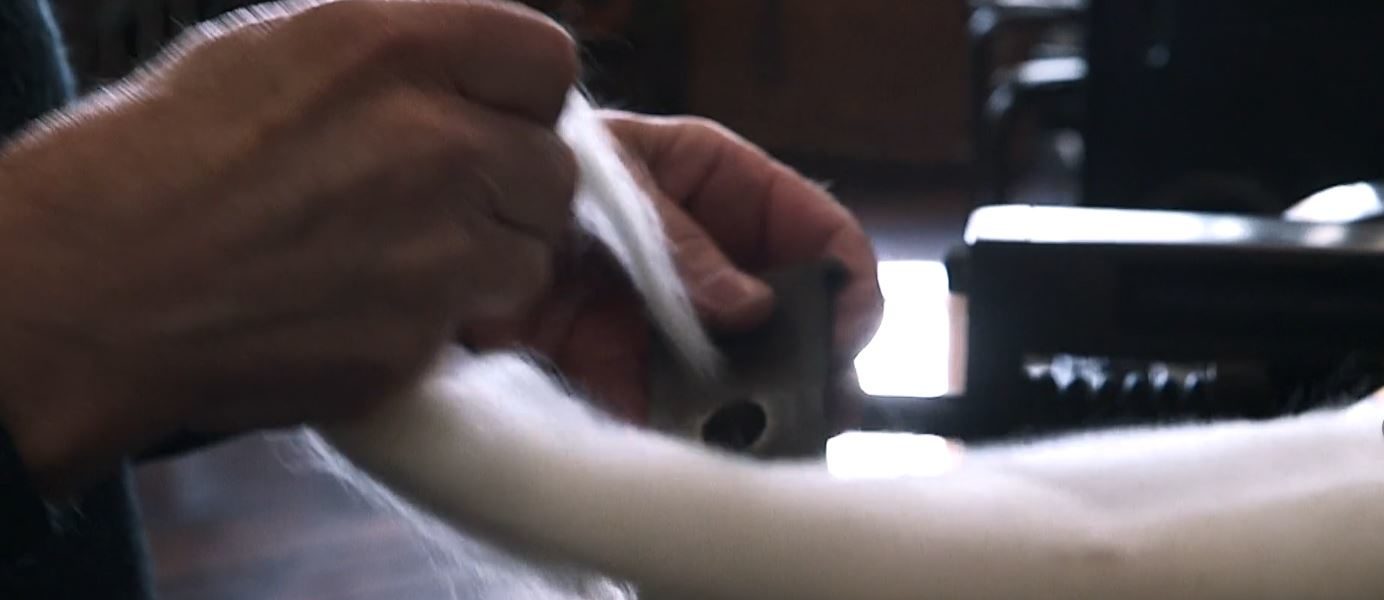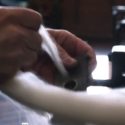Connecting with industrial heritage collections using video production methods
Greg Kotovs and the can-gill machine
Article DOI: https://dx.doi.org/10.15180/221808
Abstract
This article consists of one short video and accompanying reflective documentation. The video focuses on museum volunteer Greg Kotovs and his operation of a can-gill machine at the Bradford Industrial Museum. It attempts to acknowledge the historical worker’s embodied expertise, and a certain epistemology associated with the knowledge of the industrial maker. In this way, it connects two kinds of discipline – discipline in terms of the skilled worker’s body, and discipline in terms of the organisation of knowledge.
As appropriate to an Action Research project, the text component of the article focuses on the evolution of my practice as a ‘research filmmaker’ over the course of the investigation. I pay particular focus to how film production has become an opportunity to engage with objects of industrial heritage being used, and I reflect on the significance of creating such footage.
Keywords
Bradford, craft, embodiment, film, gestural knowledge, industrial heritage, industry, re-enactment, tacit knowledge, working lives
Introduction
https://dx.doi.org/10.15180/For this investigation, I initially attempted to use video production methods to make two kinds of ‘connection’ with and between industrial textile manufacturing collections. The first represented a depth of connection, focusing on physical museum objects being used. The second was an attempt to make connections across collections, connecting objects with, for instance, oral history and archival documents. As my investigation progressed, my attempts at the latter tended towards traditional documentary production, albeit without the crew, time or story to produce a satisfactory production. A documentary would not, in any case, have constituted an innovation. During production, Congruence Engine partner Simon Popple suggested attempting to crowdsource stories and democratise the process of making connections between collection items. This second direction – attempting to make connections across different collections – became a separate research focus beyond the scope of this article. I confined the present investigation to creating and making manifest meaningful encounters between industrial heritage objects and their users. I focused particularly on volunteer Greg Kotovs operating a can-gill machine on display at Bradford Industrial Museum in the Summer of 2022.
The above video of Kotovs operating the machine is the result. Superficially, the film is a record of Kotovs demonstrating a specific part of the ‘drawing’ stage of worsted yarn production. We see him turning on the machine and feeding it with a mass of combed wool. The fibres then make their way through a series of slow-moving rollers and combs and onto faster-moving rollers before being deposited into a can at the end of the process. The action of these rollers and combs ‘draws out’ the wool, Kotovs explained, making the product four times longer and four times thinner.
The unassuming, compact machine is the first of six showing the Bradford Open Drawing system on display at the Museum, an innovation betraying Bradford’s international reputation as ‘Worstedopolis’. ‘Drawing’ (or ‘drafting’) is the process of further drawing out already-combed wool, removing lumpy and over-long fibres. It is a procedure somewhere in the middle the manufacturing process. Wool has to be first washed and sorted, then combed before it can be drawn. Then it has to be spun and twisted, and wound onto bobbins before use in garment manufacture. Not only does the can-gill feel somewhat lost amongst these other ‘drawing’ machines, all performing broadly similar tasks, it is part of a wider community of machines representing a complex production process. The exhibition is curated to enable a visitor to appreciate the manufacturing process in its entirety, following the material from machine to machine, from sheep to bobbin. The video, conversely, isolates the can-gill machine from its many counterparts, and also from the visual clutter and noise of the Museum floor.
The resulting film is simple in its construction and precise in its focus on the individual machine and Kotovs’s interaction with it. This article is a reflection on the significance of such a recording as a way to connect with and accommodate the tacit or embodied dimensions of an object in use. It leads to this paper’s proposition: that video production might be used to formally acknowledge the multimodal dimensions of collection items, to recognise the economy of knowledge, skill and expertise practiced historically by workers operating particular machines, yet often overlooked in written historical accounts.
Video and the multimodal richness of industrial heritage collection items
https://dx.doi.org/10.15180/221808/002Historians have long refined methods for interpreting archives, notebooks and other textual sources. When Bruno Latour referenced the landmark study Leviathan and the Air-Pump, he noted that the study’s authors, Shapin and Schaffer, ‘had access to thousands of archival pages on Boyle’s ideas’ (Latour, 1993). Such an abundance of written primary sources makes it a relatively straightforward matter for historians to study how subjects (like Boyle) constructed objects (like the air pump). Yet, for Latour, telling and supporting such stories represents only ‘half’ of history. The second ‘half’ is harder to study. Latour characterises it as studying how objects constructed historical subjects; how the physical, material, built world shaped historical actors. Returning to Shapin and Schaffer, Latour notes that for this dimension of historical research, the historians were left with only unanimated objects – ‘silent, brute remainders such as pumps, stones and statues’. Despite the wealth of primary material available to them, the two scholars had no access to information about the ‘tacit practice of the air pump or…the dexterity it required’ (Latour, 1993). And, as a traditionally text-centric discipline, history lacks ways of engaging with its tacit and embodied dimensions.
Historians have nevertheless suggested, in studies of materials (AHR Conversation, 2009; Smith and Findlen, 2002; Daston, 2004; Klein and Spary, 2009; Findlen, 2013; Smith et al, 2014), gender (Hannan, 2018; Fara, 2004; Pennell, 2016) and space (Livingstone, 2003), that contributions to knowledge production and science are not always written, spoken or even discursive. Such studies have furthermore suggested that embodied or performative contributions to history – those historically made by artisans, workers and particularly women in domestic spaces – have tended to go unrecognised since the mid-nineteenth century (Roberts, 1995). Others have attempted to use re-enactment methods to directly engage with and make explicit the knowledge produced through making or using objects, or performing tasks (Settle, 1961; Drake, 1970; MacLachlan, 1976; Principe, 1987; Heering, 1992; Otto Sibum, 1995; Otto Sibum, 2020).
We might see industrial heritage in two such ‘halves’. On the one hand, we have no shortage of archival sources, diaries or secondary literature on people like Samuel Crompton (inventor of the Spinning Mule) or John Kay (inventor of the flying shuttle). Their lives have been fleshed out, supported by their own writings and those who knew them. On the other hand, we are also privileged to have a corresponding material record of working lives and working culture. The collection of Bradford Industrial Museum is one such record. My recording of the can-gill machine in use, along with Greg Kotovs’s operation of it, constituted an engagement with the tacit knowledge required to operate the machine, Kotovs’s embodied expertise, the unspoken understanding of a piece of material, industrial heritage, and the demands placed on an industrial maker.
We might, furthermore, see the operation of a machine as a form of historical re-enactment. Although operating a can-gill machine is, in one way, fairly straightforward, it involves some expertise. On the face of it, the operator is simply feeding the machine with wool, letting the mechanism do the rest. But their body is intricately engaged with the process: fibres must be inserted correctly, and the mechanical components must be calibrated – a procedure that could be worked out exactly using a formula, though experienced and skilful can-gill operators were able to intuit or guess the appropriate speeds for the fibres presented to them (Hutton, 1911). The procedure may be functional and industrial – and is certainly associated with working-class heritage – but seeing the simple operation as a re-enactment in this way invites us to emphasise the rich knowledge and expertise that lie behind seemingly simple engagement with such objects.
In my earlier work, I have used video to acknowledge what Pamela H Smith calls ‘artisanal epistemology’ – the knowledge created and made manifest through artisanal making, through makers interacting with tools, materials and their environments (Smith, 2004). I have used video, for instance, to emphasise the role that the gendered craft of embroidery played in the history of vascular surgery, focusing on the expertise of nineteenth-century embroiderer Marie Anne Leroudier. In this investigation, I worked with an embroiderer, Fleur Oakes, to re-enact vascular anastomosis, filming the precise aspects of Leroudier’s technique shared by vascular surgery (Craddock, 2022). I have also used video as part of the V&A’s Encounters on the Shop Floor project to evoke the knowledge shared by practitioners working in crafts as diverse as pottery and classical guitar playing (Craddock, forthcoming). In both cases, my research has acknowledged the multimodal ways in which knowledge was made manifest, ways of knowing overlooked by traditional, text-based history. In this short, reflective piece accompanying this video submission, I have not the space to expand on my evolving use of film production as a historical research method. Suffice it to say, my arguments and their scholarly context can be found in the above two full-length articles. I suggest that the present video extends the idea of an ‘artisanal epistemology’ to encompass the industrial maker, their tools and environments.
Coda: democratising the connection of textile collections
https://dx.doi.org/10.15180/221808/003The methodological and epistemological considerations outlined above tended towards the significance of people connecting with objects of industrial heritage. The connection I chose to expand on is deep, rather than broad. When we engage with objects through a form of re-enactment, and record that encounter, we connect with a non-verbal, non-written, non-discursive way of making and manifesting knowledge. When it came to making connections across collections, on the other hand, the University of Leeds’s YARN platform presented an exciting new possibility to democratise the making of stories, meaning and connections.
The platform enables users to link to items – websites, videos, images, writing – and connect them using text. Others might then be invited to contribute their own stories. Users can even upload their own photographs, sound recordings and other media. It also enables users to include other elements not easily included in an edited film – websites, documents and so on. YARN also has the advantage of being easy to use. Working with video requires some familiarity with video editing software, even when working with archival material. This technological requirement puts meaning-making potential out of reach of many. Copyright problems are also sidestepped by using links. The material is never fixed in place as part of a new work. It is only ever referenced. Copyrighted material can in this way be linked and form part of stories.
When presented with a tool that democratised the privilege of making connections between collection items – and in the absence of a particular ‘story’ to tell – it felt inappropriate to formalise connections in a traditional film form. And this led me to reflect further on the initial video I produced with Kotovs, about the can-gill machine. I felt able to engage deeply with Kotovs and the can-gill machine, since I did not intend to make a film about the machine or Kotovs. Rather, I made the video with Kotovs. And this video was not produced as a piece of footage to be consumed in a traditional way. It was part of my research practice. As a filmmaker, I routinely produce complex films with high production values, designed to be watched by a variety of professional and public audiences. As a ‘research filmmaker’, however, I am uncomfortable being the sole authorial voice. My research practice has grown to be one of acknowledging artisanal and industrial epistemologies, and using video to accommodate them into scholarly practices. Greg Kotovs and the can-gill machine is part of an ongoing research practice into the way that makers of different kinds produce knowledge, and make it manifest.



